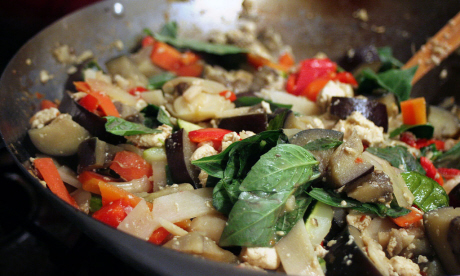
Does travel affect your waistline and are you likely to come back lardy or lean? Advice to help you make your next trip healthier
Other countries tend to place a greater emphasis on food quality: dishes tend to contain fewer additives than in the UK. Eating plenty of fresh fruit and vegetables will increase antioxidant intake, reduce cancer and heart disease risks and make diabetes less likely. However, travellers need to be careful when eating raw foods in regions where sanitation is poor.
If you’re unsure about food hygiene, forgo your five a day. For example, salads can be bad news on the Indian subcontinent and tropical Latin America. Coconuts are perfectly hygienic (as long as they’re not pre-opened, with ice added) but are packed with saturated fats – the unhealthy kind. Note that if foods are dried or sugary then there’s no need to be squeamish about cleanliness. Buffets not only encourage over-eating, but can be dodgy if the power supply is unreliable. Seafood buffets should be treated with caution; those on Nile cruises are notoriously risky.
Airline meals can be very disappointing. One survey calculated that the average inflight platter contains 1,054 calories and 52g of fat. Given that the average sedentary man/woman needs about 2,500/2,000 calories, this is a large proportion of the daily requirement, at a time when you don’t need an energy boost.
One option is to pre-order a low-salt or low-fat meal; the other is to burn it off on arrival. Note: temperature as well as level of activity determines calorie needs: for example, those exercising hard in Arctic climes require up to 7,000 calories a day.
Safari tours, expedition cruising, car-bound city tours… Some trips, by their nature, lead to long periods of inactivity, often combined with extravagant meals. You can counter this, however: go for an early swim in the local pool, play Frisbee in the park or do some basic keep fit in your hotel room. One thigh-toning exercise that can be done almost anywhere isstep-ups onto a dining-type chair: aim for 50 step-ups leading with your right leg, 50 with your left.
Some people set off on a trip specifically to burn fat. The best activities are those that increase your heart rate and make you out of breath. Exercising for 45 minutes increases your metabolic rate for 48 hours, helping you burn fat more effectively. Be sure you get fit before departure if you want to make the most of your time. And beware of wasting all the effort by drinking too much afterwards.
The benefits of activity trips vary significantly. A yoga or t’ai chi course will tone you up, improve your posture and help any back troubles, while a gentle downriver canoe trip with frequent stops for food and wine won’t leave you so trim. Spa holidays are great if you’re stressed, even if they don’t always contribute to physical health improvements. Saunas won’t help you lose weight.
Doing a little fitness work while away gives you more energy, raises endorphin levels and improves wellbeing. Going for a run in a new country will introduce you to areas you may not have visited otherwise, and sometimes leads to unexpected introductions. Do your homework, though – in some places cultural constraints might discourage stripping down to your shorts.
One bug worth mentioning is cyclospora, which causes weight loss of several kilograms (sometimes as much as 10kg) in several weeks. It is associated with mild diarrhoea that comes and goes over two to 12 weeks and is cleared by a week-long course of co-trimoxazole.
Jet-lag, fatigue and parasitic hitch-hikers all knock the appetite but if you stop enjoying food, this is something else to mention to your doctor back home.